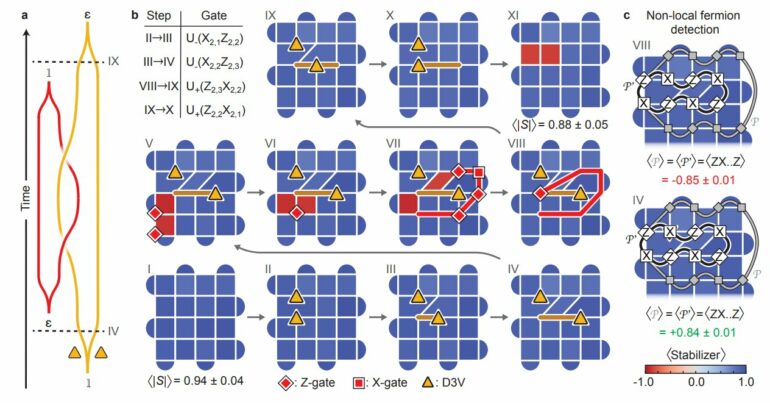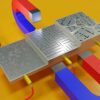Some classical computers have error correction built into their memories based on bits; quantum computers, to be workable in the future, will need error correction mechanisms, too, based on the vastly more sensitive qubits.
Cornell researchers have recently taken a step toward fault-tolerant quantum computing: they constructed a simple model containing exotic particles called non-Abelian anyons, compact and practical enough to run on modern quantum hardware. Realizing these particles, which can only exist in two dimensions, is a move towards implementing it in the real world.
Thanks to some creative thinking, Yuri Lensky, a former Bethe/Wilkins/Kavli Institute at Cornell (KIC) postdoctoral fellow in physics in the College of Arts and Sciences (A&S), collaborating with Eun-Ah Kim, professor of physics (A&S), came up with a simple “recipe” that could be used for robustly computing with non-Abelian anyons, including specific instructions for executing the effect experimentally on devices available today.
Their paper, “Graph Gauge Theory of Mobile Non-Abelian Anyons in a Qubit Stabilizer Code,” written in collaboration with theorists at Google Quantum AI, published March 24 in Annals of Physics. Google Quantum AI researchers, together with Lensky and Kim, have proved the theory with a successful experiment as reported in a preprint publication, “Observation of Non-Abelian Exchange Statistics on a Superconducting Processor,” on the research-sharing platform arXiv.
“This two-dimensional state is interesting both from a quantum condensed matter physics perspective—it has some novel properties that are very special to 2D physics—and from a quantum information perspective,” Lensky said. “It’s something truly quantum, but it’s also potentially useful for quantum computation. It protects bits of quantum information by storing them non-locally, and our protocol allows us to compute with these bits.”
Kim explained the principle that animates non-Abelian anyons by holding out two identical one-pound barbells. When she crosses her arms, the identical barbells change positions, but as objects defined by classical physics, their state remains the same. They are interchangeable.
If those barbells represent two identical quantum particles, remarkably in certain 2D systems their trails through space-time can produce a measurable record of the change (picture the crossed arms.) This process of exchange is called a braid, after the shapes of the particle trails.
“Quantum mechanically, when you move one particle around the other,” Kim said, holding one weight still and moving the other in a circle around it, “the wave function, which is a solution to the Schrödinger equation describing quantum mechanical motion, can be multiplied by a phase factor or it can become something that’s very different.”
When the wave function gains a global sign that can only be observed through interferometry, a measurement of the interference of waves, that’s called an Abelian anyon. When the wave function becomes measurably different, it’s a non-Abelian anyon, she said.
Non-Abelian anyons could be harnessed to create qubits defined not on a single particle, but on a pair of identical quantum particles: nonlocally encoded.
“If I put the qubit shared between these particles in a zero state and move them apart, then whatever happens locally to one of these anyons, the zero state will remain. The qubit set to zero is safe from corruption,” Kim said. “Non-Abelian anyons could be used in a platform for protected qubits.”
But while physicists have theorized about these exotic particles for years—Alexei Kitaev proposed operating on protected bits of quantum memory by braiding non-Abelian anyons back around 2001, Lensky said—they have never been observed in a physical system before now.
When Google Quantum AI developed the quantum processor platform capabilities to realize the surface code and braiding of Abelian anyons in a physical system, Lensky said, “This was [our] inspiration to look for a way to realize the physics of non-Abelian anyons as soon as possible.”
“We knew they had the working ingredients, but they didn’t have a recipe,” Kim said. “We figured out how to move these non-Abelian anyons, then we told the experimentalists what to do. It was possible because Yuri and I were thinking in a flexible, creative and open-minded way.”
Past theoretical research identified non-Abelian properties, but came up short on how to move them, a necessary step. A key insight from Lensky and Kim was to give up the regularity of a grid and arrange qubits in an almost hand-drawn manner but backed up by robust mathematics.
“After this simple geometric insight, using gauge theory, we were able to come up with the protocol of taking this picture and implementing it on a chip in a robust and efficient way,” Kim said. “With this 10-qubit system, we were able to encode multiple non-Abelian anyons, and therefore multiple logical information-carrying qubits, and a precise recipe for what the experimentalists need to do every step of the way.”
“Although the focus of the theory and experiment is simply to realize non-Abelian anyons in the real world, this can also be viewed as a first small step towards implementing computation by braiding,” Lensky said.
More information:
Yuri D. Lensky et al, Graph gauge theory of mobile non-Abelian anyons in a qubit stabilizer code, Annals of Physics (2023). DOI: 10.1016/j.aop.2023.169286
Trond I. Andersen et al, Observation of non-Abelian exchange statistics on a superconducting processor, arXiv (2022). DOI: 10.48550/arxiv.2210.10255
Provided by
Cornell University
Citation:
Physicists take step toward fault-tolerant quantum computing (2023, April 12)



